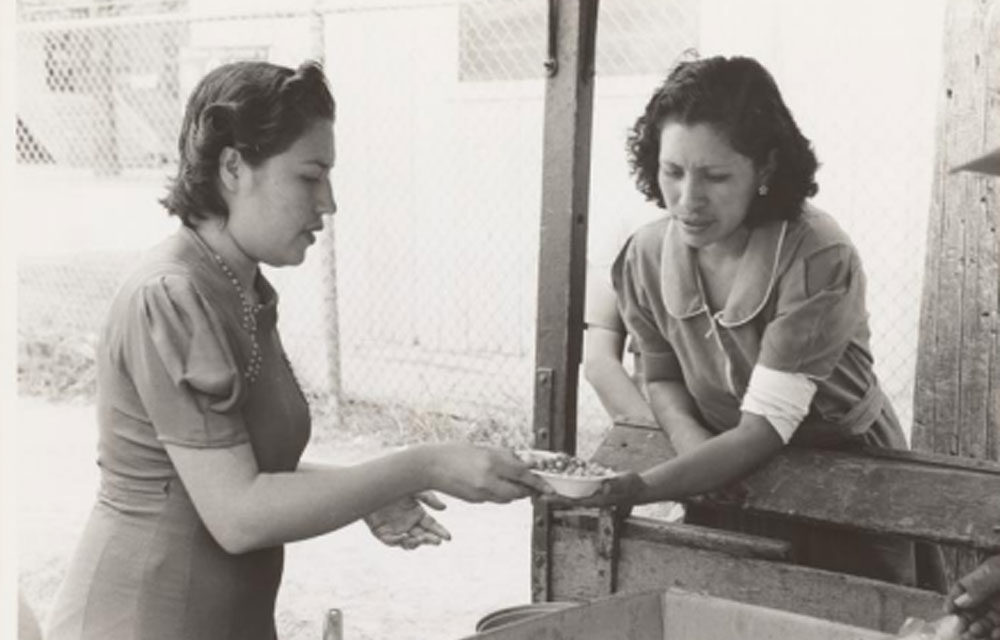In 1933, Emma Tenayuca, a seventeen year old high school honor student, a member of the debate team, and star player in both basketball and baseball at Brackenridge High in San Antonio, joined striking women on the picket line at H.W, Finck Cigar Company of San Antonio. The women workers demanded higher wages. Police arrested Tenayuca along with other women. From that fateful day on, her life would never be the same.
Over the next five years Tenayuca joined every labor protest activity in San Antonio, and ultimately led a strike of 10,000 pecan shellers. She was a pioneer in a world dominated by male labor leaders, and her activism paved the way for other Latina women to assume leadership roles in America’s labor movement.
Tenayuca grew up in San Antonio’s Westside, the poorer and Mexican side of the city where she lived with her maternal grandparents. Her grandfather, Francisco Zepeda, often took Emma to the labor gatherings at Milam Park, then known as La Plaza de Zacate, to hear the soap box speakers defend socialism. Leftest labor leaders preached the gospel of labor fairness and justice to all gathered there.
Tenayuca formed a friendship with Mrs. W.H. Ernst, the leader of the Finck cigar strike and took a lead in 1934-35 in forming two locals for the Ladies’s Garment Workers’ Union [ILGWU]. Across America, garment workers were difficult to organize, and San Antonio proved no exception. In the meantime The Roosevelt Administration passed the Work Projects Administration [WPA] in 1935 aimed at creating federally supported jobs lessening the burden of the Great Depression.
While the WPA initiated over 600,000 jobs in Texas, Tenayuca and her labor associates did not see that the government’s efforts were helping a sufficient number of the unemployed Mexican Americans in San Antonio. Over the years 1936-38, Tenayuca took a lead in public demonstrations and sit-ins against the unequal distribution of Work Projects Administration [WPA] jobs.
Moreover, with the loss of jobs due to the Great Depression, the Roosevelt Administration gave the United States Border Patrol greater authority to deport immigrants. Tenayuca organized opposition to the Border Patrol’s round-up of Mexican immigrants in San Antonio in 1935 and also utilized her labor contacts in Mexico to explore ways to help those who had been deported.
Tenayuca traveled to Mexico to meet with labor leaders in 1936 and returned with ideas of forming new labor unions modeled after the left-leaning Confederación de Trabajadores de México [CTM].
The following year, 1937, Tenayuca married Homer Brooks, the chairman of the Communist Party of Texas. While the couple were active across the state, Tenayuca devoted most of her time to assisting San Antonio Mexican American workers. Tenayuca was active in the Workers Alliance of America and learned in early 1938 of a strike by the pecan shellers of San Antonio.
A decision by the Southern Pecan Shelling Company to cut wages by nearly 20 percent that year led to a call for mass walkout of the employees. Although Tenayuca was not a pecan sheller herself, the striking workers in this industry, largely Mexican American women, pinned their hopes for a successful outcome on the leadership of the 22-year-old charismatic Tenayuca.
My mother, Alicia Saenz, started shelling pecans at home with her mother and sisters after dropping out of school in 1933. In the early days of the Depression her dad had lost his job and her mother, who worked cleaning houses and cooking meals for a ranch family, also found herself unemployed.
Alicia Saenz had just completed the fifth grade when she left school to help her family. She worked five years as a pecan sheller, mostly in her home living room. She knew, even at her young age, that her family’s options for survival–having a roof over their heads and food on the table–meant that everyone in the household had to help. She was one of almost 12,000 pecan shellers who earned as little at $1.50 for a 40-50 week. Historians R. Matt
Abigail and Jazmin Leon studied the pecan shellers’ strike and wrote: “Strikers were subjected to mass arrests and tear gas, and Tenayucaca’s Communist Party membership was criticized by the national press.”
In their favor, the striking workers looked to Roosevelt’s Fair Labor Standards Act passed in 1938 that called for a minimum wage rather than the unscrupulous piece rate. Rather than to pay a fair wage, however, the company owners secured new machinery which eliminated the jobs of approximately 10,000 workers.
When the machines replaced the workers in the shops, unemployed workers turned to other jobs, which were almost non-existent or relied on government or religious relief programs. Tenayuca left San Antonio and worked odd jobs in Houston for a short time. In the late 1940s she moved to California and completed a teaching degree from San Francisco State University.
Tenayuca returned to San Antonio in the 1960s and taught bilingual education in the Harlandale School District until her retirement in 1982. She passed away in 1999 in San Antonio. A new generation of Chicano labor historians at the University of Texas-Austin, at the University of California Berkeley, and at Los Angeles [UCLA] campuses in the 1970s began to uncover the role of labor leaders like Tenayuca.
I was an early member of the National Association of Chicano and Chicana Studies [NACS] in the mid 1970s while studying American history at UCLA. I am proud to have attended history sessions at NACS that discussed Tenayuca and other women labor leaders. The stories of these early defenders of fair wages and working conditions are rich and merit greater exposure.
Emma Tenayuca: A Warrior for Working Women












